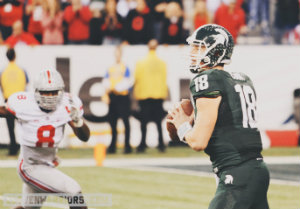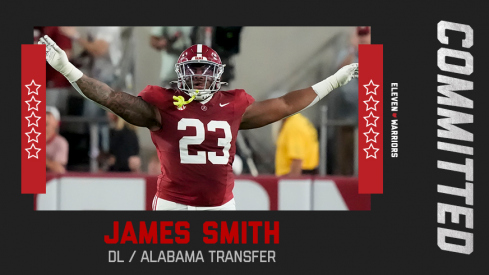
This is the first time I've written a losing Beyond the Hashes, and it doesn't feel great. The Buckeyes played an extremely streaky game, from the defensive efficiency, to both Hyde and Braxton alternating effectiveness and explosive plays, to overall offensive drive efficiency.
It was Sparty punch, Buckeye counter-punch, and then Sparty knockout, with time expiring before Braxton and Hyde could stabilize for a final swing. The numbers below aren't pretty, and it's sometimes just self-flagellation to read a detailed description of a loss, but hopefully they provide both context and depth for the emotional pit in your stomach.
Yards Come and Go
Hyde and Braxton's legs were almost the only way the Buckeyes could generate yards, but their effectiveness varied significantly over the course of the game. Below are the Buckeyes' running back success rates, with explosive plays in parentheses:
| 1Q | 2Q | 3Q | 4Q | |
|---|---|---|---|---|
| Braxton | 0% (0) | 57% (3) | 67% (1) | 40% (0) |
| Hyde | 100% (0) | 25% (0) | 75% (1) | 50% (0) |
The fourth quarter was difficult to watch. The 4th and 2 was undoubtedly the play of the game for the Spartans, in which Herman decided on an outside zone with Hyde leading. While the play had been extremely successful earlier in the game, Narduzzi had seen enough of it by that point.
In fact, the running back success rates really illustrate how much of a chess match this game was for Herman and Narduzzi. Hyde and Braxton's RBSR's completely flip-flop by quarter. Braxton found some running room – and really tried to put the team on his back (or legs, more accurately) – during the Buckeyes' 24-point run in the middle of the game.
Overall Efficiency: Not So Good
| PPP | YPA | Ex. Plays | PoPP | PLPP | |
|---|---|---|---|---|---|
| OSU Offense | .380 | 5.94 | 6 | 1.85 | 4.85 |
| OSU Defense | .436 | 6.08 | 6 | 2.83 | 6 |
- This was obviously the least-efficient performance the Buckeyes had on offense all season. While six explosive plays is not bad based on the season average, they were all concentrated in the middle third of the game. The Buckeyes gained just 46 total yards after the 5:36 mark in the third quarter.
- Before the game I felt very confident that the team that won the turnover margin would win the game. At +1 for the Buckeyes, obviously that wasn't the case. However, the Buckeyes' next drive was a punt after eleven yards, so it had a negligible effect on the game.
- For the first time all season, the explosive play margin was zero. That actually was the difference in the game – not the turnover margin. The Buckeyes allowed three explosive pass plays to spring the Spartans in to their first seventeen points, then three rushing explosive plays to finally put the game out of reach in the fourth quarter.
- The Spartans bucked their offensive statistical trends from previous games. Not only did MSU have more explosive pass plays than anyone expected, but they had longer drives, and converted more third downs, than their previous twelve games.
- Conversely, the Buckeyes had just one third down conversion the entire game. When you can't win first or second down, third down becomes simply unmanageable. The Buckeyes typically won first down despite rushing on seventeen of 31 first down attempts for 130 yards (7.67 YPA). The problem was first down passing – the Buckeyes were 4/13 passing on first downs.
- Obviously Cook's performance was the difference in the game, as he passed for a career high and his second-greatest number of attempts.
- While the offense has had great success with the two-minuted drill to close out the first half before, the offense had a surprising inability to pick up yards quickly through the air when playing from behind. The offense only threatened with the ground game, and the passing game was almost only effective off of play action and short packaged passes. Without the threat to run the ball (late in the fourth quarter), the offense still couldn't pick up yards without the threat to run opening play action.
- Regardless, Hyde, Braxton, and the offensive line turned in gutsy performances on the ground. They deserve all the credit in the world for running on that defense. Good luck, Cardinals.
Efficiency in Three Acts
It was truly remarkable how the game momentum shifted twice throughout the game. After the Spartan's furious start, the Buckeyes settled in and looked like they might run away with it during the third quarter, only for the Spartans to go on a 17-0 run to close the game.
Momentum is a tricky thing in sports analytics. While your eyes see streaks of points on the field (as well as fired up/dejected sideline demeanor), there really isn't any empirical basis for "the hot hand." Regardless, the game really had three acts, and the Spartans led two of them. Below are the efficiency metrics separated in to the three "acts:"
| YPA | PoPP | PLPP | |
|---|---|---|---|
| Start - 9:01 2Q | 2.4 | 0 | 5 |
| 9:01 2Q - 5:36 3Q | 9.1 | 4 | 5.3 |
| 5:36 - End | 2.7 | 0 | 4.3 |
The Buckeyes didn't really have longer drives during the scoring spree, just more explosive plays.
 Close, but no sack.
Close, but no sack. The division between the three acts couldn't be more pronounced than when looking at the yards per attempt. The yardage per play more than tripled, as Herman called a fantastic middle of the game.
THE UNIMPORTANCE OF FIELD Position
Everything suggested field position would be vitally important. The Spartan offense is certainly ball control oriented (except when it isn't, I guess), while their offense has only shown the ability to score when the defense or special teams set them up.
However, field position really didn't determine the outcome of the game. Despite four drives starting on the Buckeyes forty yard line or better – meaning less than sixty yards to a touchdown – the Buckeyes only received points off of one of those possessions. As already mentioned, the interception resulted in four plays and a punt as well. If you go against Tresselball, you have to take advantage of advantageous field position.

